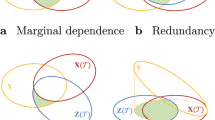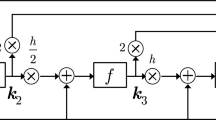Abstract
This paper presents an improved non-iterative random vector functional link network hybrid model with better input-output representation, improved generalization for nonlinear dynamic system identification. The modified random vector functional link network model uses random weights between the input layer and hidden or enhancement layer neurons whose outputs are obtained by using two suitably weighted activation functions and additionally it provides a weighted direct link between the trigonometric functions based exponentially expanded the inputs and the output node. This novel architecture provides a direct link of inputs and its nonlinear expanded version in a higher dimensional space to the output node along with a randomized version of the hidden layer operating with an optimized added activation function to handle the chaotic nature of the non-linear dynamic systems. Also the weights and the parameters associated with the summed activation functions are optimized using an efficient modified sine cosine algorithm based monarch butterfly algorithm with levy distribution optimization algorithm with better exploitation and exploration capabilities in order to improve overall identification accuracy. To authenticate the efficiency of the proposed model, five benchmark dynamic plants are examined; the achieved outputs are compared with recognized methods like extreme learning machine, conventional random vector functional link network, and enhanced random vector functional link network with single activation function and least mean square. The method proposed here exhibits improved performance accuracy which is superior to the considered models. The proposed model is also compared with some iterative existing methods and found suitable by taking into consideration the merits of non-iterative approach,















Similar content being viewed by others
References
Wang Y, Ding F (2016) Filtering-based iterative identification for multivariable systems. IET Control Theory & Applications 10(8):894–902
Patra J. C, Kot A. C (2002) Nonlinear dynamic system identification using Chebyshev functional link artificial neural networks. IEEE Transactions on Systems, Man, and Cybernetics, Part B (Cybernetics) 32(4):505–511
Han X, Xie WF, Fu Z, Luo W (2011) Nonlinear systems identification using dynamic multi-time scale neural networks. Neurocomputing 74(17):3428–3439
Tavoosi J, Suratgar AA, Menhaj MB (2016) Nonlinear system identification based on a self-organizing type-2 fuzzy RBFN. Eng Appl Artif Intell 54:26–38
Chaudhary NI, Raja MAZ, Aslam MS, Ahmed N (2018) Novel generalization of Volterra LMS algorithm to fractional order with application to system identification. Neural Comput & Applic 29(6):41–58
Yu W (2004) Nonlinear system identification using discrete-time recurrent neural networks with stable learning algorithms. Inf Sci 158:131–147
Kumpati SN, Kannan P (1990) Identification and control of dynamical systems using neural networks. IEEE Trans Neural Netw 1(1):4–27
Wang S, Han Z, Liu F, Tang Y (2015) Nonlinear system identification using least squares support vector machine tuned by an adaptive particle swarm optimization. Int J Mach Learn Cybern 6(6):981–992
Camps-Valls G, Martínez-Ramón M, Rojo-Alvarez JL, Muñoz-Marí J (2007) Nonlinear system identification with composite relevance vector machines. IEEE Signal Processing Letters 14(4):279–282
Feldman M, Braun S (2017) Nonlinear vibrating system identification via Hilbert decomposition. Mech Syst Signal Process 84:65–96
Lei Y, Xia D, Erazo K, Nagarajaiah S (2019) A novel unscented Kalman filter for recursive state-input-system identification of nonlinear systems. Mech Syst Signal Process 127:120–135
Vafamand N, Arefi MM, Khayatian A (2018) Nonlinear system identification based on Takagi-Sugeno fuzzy modeling and unscented Kalman filter. ISA Trans 74:134–143
Mattsson P, Zachariah D, Stoica P (2018) Recursive nonlinear-system identification using latent variables. Automatica 93:343–351
Huang GB, Zhu QY, Siew CK (2006) Extreme learning machine: theory and applications. Neurocomputing 70(1–3):489–501
Huang GB, Zhu QY, Siew CK (2004) Extreme learning machine: a new learning scheme of feedforward neural networks. In 2004 IEEE International Joint Conference on Neural Networks (IEEE Cat No 04CH37541) IEEE 2:985–990
Qu BY, Lang BF, Liang JJ, Qin AK, Crisalle OD (2016) Two-hidden-layer extreme learning machine for regression and classification. Neurocomputing 175:826–834
Huang GB, Ding X, Zhou H (2010) Optimization method based extreme learning machine for classification. Neurocomputing 74(1–3):155–163
Tang Y, Li Z, Guan X (2014) Identification of nonlinear system using extreme learning machine based Hammerstein model. Commun Nonlinear Sci Numer Simul 19(9):3171–3183
Huynh HT, Won Y (2011) Regularized online sequential learning algorithm for single-hidden layer feedforward neural networks. Pattern Recogn Lett 32(14):1930–1935
Pao YH, Park GH, Sobajic DJ (1994) Learning and generalization characteristics of the random vector functional-link net. Neurocomputing 6(2):163–180
Vukovic N, Petrovic M, Miljkovic Z (2018) A comprehensive experimental evaluation of orthogonal polynomial expanded random vector functional link neural networks for regression. Appl Soft Comput 70:1083–1096
Henrıquez PA, Ruz GA (2018) A non-iterative method for pruning hidden neurons in neural networks with random weights. Appl Soft Comput 70:1109–1121
Zhang I, Suganthan PN (2016) A comprehensive evaluation of random vector functional link networks. Inf Sci 367:1094–1105
Pratama M, Angelov PP, Lughofer E, Er MJ (2018) Parsimonious random vector functional link network for data streams. Inf Sci 430:519–537
Sahani M, Dash PK (2019) FPGA-based online power quality disturbances monitoring using reduced-sample HHT and class-specific weighted RVFLN. IEEE Transactions on Industrial Informatics 15(8):4614–4623
Lian C, Zhu L, Zeng Z, Su Y, Yao W, Tang H (2018) Constructing prediction intervals for landslide displacement using bootstrapping random vector functional link networks selective ensemble with neural networks switched. Neurocomputing 291:1–10
Qiu X, Suganthan PN, Amaratunga GA (2018) Ensemble incremental learning random vector functional link network for short-term electric load forecasting. Knowl-Based Syst 145:182–196
Bisoi R, Dash PK, Mishra SP (2019) Modes decomposition method in fusion with robust random vector functional link network for crude oil price forecasting. Appl Soft Comput 80:475–493
Tang L, Wu Y, Yu L (2018) A non-iterative decomposition-ensemble learning paradigm using RVFL network for crude oil price forecasting. Appl Soft Comput 70:1097–1108
Parija S, Dash PK, Bisoi R (2020) Multi-kernel-based random vector functional link network with decomposed features for epileptic EEG signal classification. IET Signal Processing 14(3):162–174
Lin CJ, Chin CC (2004) Prediction and identification using wavelet-based recurrent fuzzy neural networks. IEEE Transactions on Systems, Man, and Cybernetics, Part B (Cybernetics) 34(5):2144–2154
Samanta S, Suresh S, Senthilnath J, Sundararajan N (2019) A new neuro-fuzzy inference system with dynamic neurons (nfis-dn) for system identification and time series forecasting. Appl Soft Comput 82:105567
Ayala HVH, dos Santos CL (2016) Cascaded evolutionary algorithm for nonlinear system identification based on correlation functions and radial basis functions neural networks. Mech Syst Signal Process 68:378–393
Lu L, Yu Y, Yang X, Wu W (2019) Time delay Chebyshev functional link artificial neural network. Neurocomputing 329:153–164
Majhi B, Panda G (2011) Robust identification of nonlinear complex systems using low complexity ANN and particle swarm optimization technique. Expert Syst Appl 38(1):321–333
Yingwei L, Sundararajan N, Saratchandran P (1997) Identification of time-varying nonlinear systems using minimal radial basis function neural networks. IEE Proceedings-Control Theory and Applications 144(2):202–208
Baldacchino T, Worden K, Rowson J (2017) Robust nonlinear system identification: Bayesian mixture of experts using the t-distribution. Mech Syst Signal Process 85:977–992
Wang GG, Deb S, Cui Z (2019) Monarch butterfly optimization. Neural Comput & Applic 31(7):1995–2014
Mirjalili S (2016) SCA: a sine cosine algorithm for solving optimization problems. Knowl-Based Syst 96:120–133
Dai W, Chen Q, Chu F, Ma X, Chai T (2017) Robust regularized random vector functional link network and its industrial application. IEEE Access 5:16162–16172
Chegini SN, Bagheri A, Najafi F (2018) PSOSCALF: a new hybrid PSO based on sine cosine algorithm and levy flight for solving optimization problems. Appl Soft Comput 73:697–726
Singh N, Singh SB (2017) A novel hybrid GWO-SCA approach for optimization problems. Engineering Science and Technology, an International Journal 20(6):1586–1601
Juang CF, Lin CT (1999) A recurrent self-organizing neural fuzzy inference network. IEEE Trans Neural Netw 10(4):828–845
Kumpati SN, Kannan P (1990) Identification and control of dynamical systems using neural networks. IEEE Trans Neural Netw 1(1):4–27
Friedman M (1937) The use of ranks to avoid the assumption of normality implicit in the analysis of variance. J Am Stat Assoc 32(200):675–701
Hájek J, Šidák Z, Sen PK (1999) Elementary theory of rank tests. In: Theory of rank tests, 2nd edn. Academic Press
Chen CLP, Liu Z (2018) Broad learning system: an effective and efficient incremental learning system without the need for deep architecture. IEEE Transactions on Neural Networks and Learning Systems 29(1):10–24
Author information
Authors and Affiliations
Corresponding author
Ethics declarations
Conflict of interest
The authors declare that there is no conflict of interest for this paper to any person or organization.
Additional information
Publisher’s note
Springer Nature remains neutral with regard to jurisdictional claims in published maps and institutional affiliations.
Rights and permissions
About this article
Cite this article
Samal, D., Dash, P.K. & Bisoi, R. Modified added activation function based exponential robust random vector functional link network with expanded version for nonlinear system identification. Appl Intell 52, 5657–5683 (2022). https://doi.org/10.1007/s10489-021-02664-0
Accepted:
Published:
Issue Date:
DOI: https://doi.org/10.1007/s10489-021-02664-0




